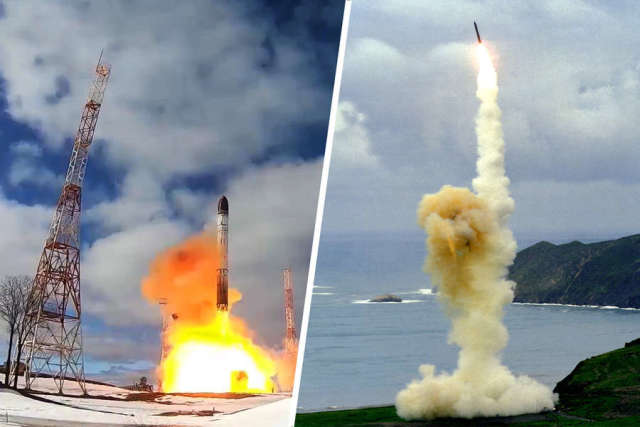The United States recognized the nuclear missile gap with Russia
Dmitry Rogozin, the head of the Roscosmos State Corporation, said that the Sarmat rocket currently being tested will be much more powerful than its predecessor Voevoda. Destroying the missile "will be almost impossible." In the United States, the Sarmat tests have intensified the discussion about a new nuclear missile strategy. Details are in the material of "Gazeta.Ru».
"In total, we will have 46 strategic combat complexes "Sarmat", they will stand in those mines where the "Voivode" is now standing. I posted a comparison video in my telegram channel, where the Sarmat leaves twice as fast as the Voivode, which means that it passes the active site in less time, so it will be extremely difficult, almost impossible to hit it even at the start. The combat control system is constantly being tested, and Roscosmos specialists are involved in the development of it.
RS-28 Sarmat is a promising ground-based mine-based missile system capable of carrying nuclear charges. "Sarmat" has been developed since the 2000s at JSC "V. P. Makeev State Rocket Center". The Krasnoyarsk Machine-Building Plant is engaged in production.
Earlier it was reported that the Sarmat should enter the Russian army in 2022, the first complex will receive the Uzhur rocket compound located in the Krasnoyarsk Territory. The timing of the arrival of the "Sarmat" in the troops has been repeatedly postponed. In the 2010s, when the Sarmat program was just being launched, it was said that a new missile system would appear in the troops by 2015, then in 2017.
"Over the past ten years, and perhaps even more, Russia has been constantly working to update and improve its fleet of ballistic missiles. At the same time, Moscow obviously had much more modest financial capabilities than the United States, was limited by outdated technologies in a number of key areas and a shortage of elements. Nevertheless, the Russian military has done this work and "opened a new page."
In the US, missile technology remains at the level of the 1970s. We will have to work hard to even out the situation. In the arms race, the Pentagon needs not to run away from Russia, but to catch up," Andrew Thompson, an American military expert, professor of the Department of International Studies at Columbia University, wrote in a column for The Wall Street Journal.
A similar opinion is shared by military analyst, former CIA officer Ryan Hillsberg, who on Fox News said that the United States now has only the LGM-30 Minuteman III missile from the ground-based arsenal of ballistic missiles.
According to Dmitry Stefanovich, a researcher at IMEMO RAS, if earlier in the United States about the creation of a new intercontinental ballistic missile "there were thoughts about the "amputation of the land leg" of the American nuclear triad, then with the advent of the Sarmat it will be almost impossible to somehow counteract the creation of the next generation of American intercontinental ballistic missiles."
"The LGM-35A Sentinel creation program will probably be activated. In general, the trends that exist in the US nuclear program will accelerate. Since the Sarmat can be equipped with hypersonic gliding cruise blocks, respectively, the Americans also say that they need hypersonic nuclear missiles. So far, all their hypersonic weapons programs have been emphatically non-nuclear," Stefanovich concluded.
Military expert Konstantin Bogdanov, in turn, believes that "the US nuclear program as a whole is now at the start of the renewal cycle."
"The United States is creating a new LGM-35A Sentinel intercontinental ballistic missile to replace the LGM-30G Minuteman III in service since the 1970s. LRSO strategic cruise missiles for heavy bombers should begin arriving by 2025 to replace the AGM-86 ALCM. This is an old rocket, it is more than 40 years old," Bogdanov said "Газете.Ru ".
At the same time, in his opinion, the problem of creating new plutonium cores, which are the basis of nuclear warheads, may become an obstacle to the US nuclear missile program.
"The head of the Nuclear Safety Department of the US Department of Energy, Jill Gruby, once again confirmed that the old plan - 80 cores by 2030 - is unattainable, because production facilities and staffing need to be restored in a number of areas. The United States at one time had a simple production of plutonium and not so much plutonium as products based on it. It's not about technology, but about the fact that they don't have production facilities now," Bogdanov summed up.
Irina Alshayeva

